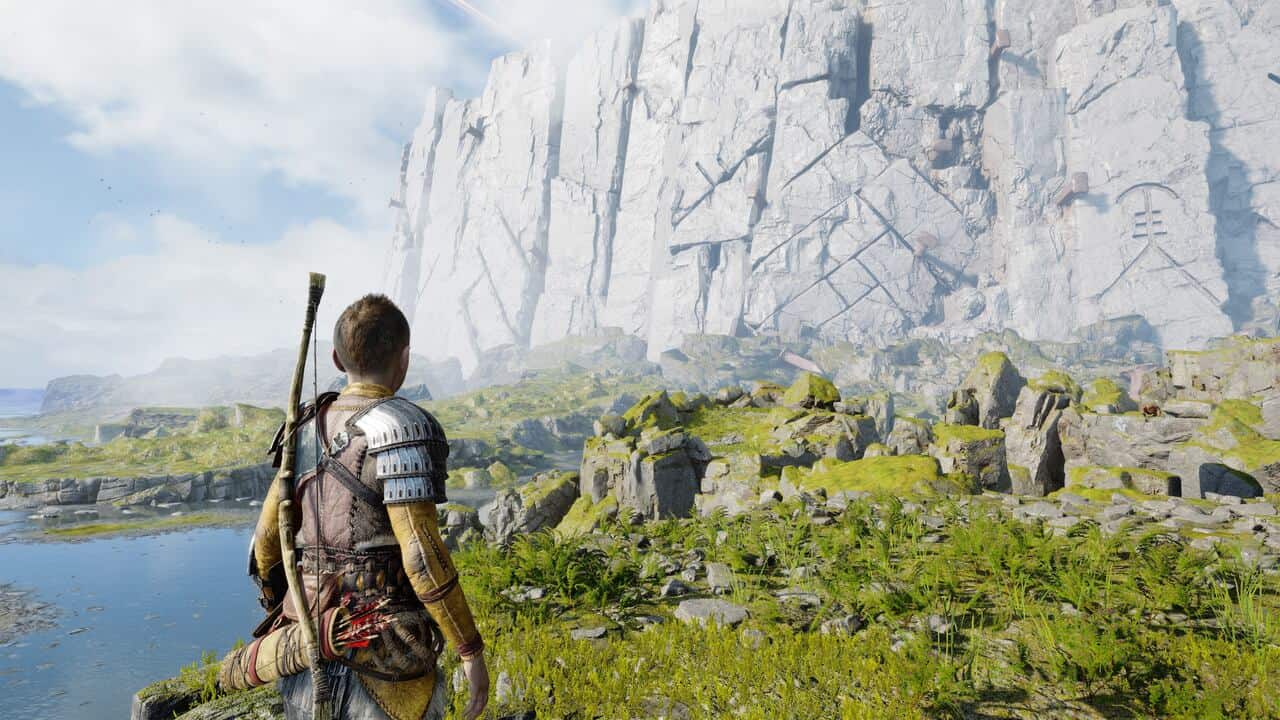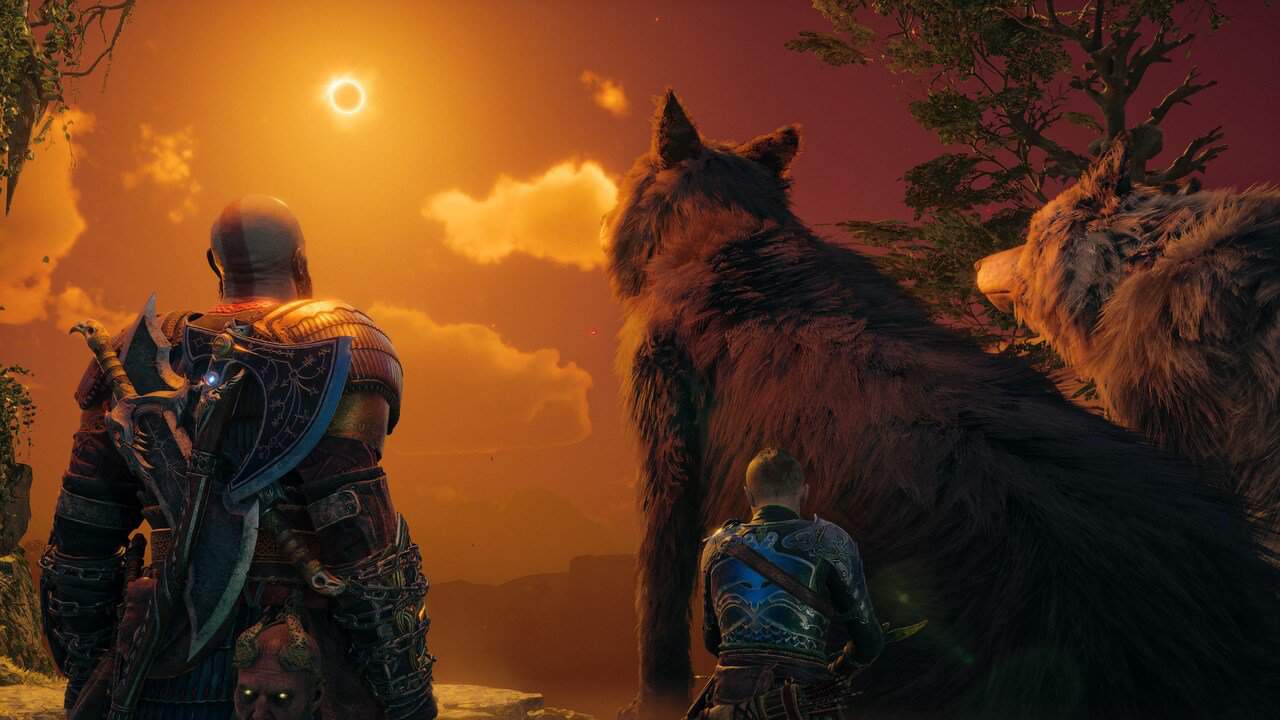You can trust VideoGamer. Our team of gaming experts spend hours testing and reviewing the latest games, to ensure you're reading the most comprehensive guide possible. Rest assured, all imagery and advice is unique and original. Check out how we test and review games here
Playing God of War Ragnarok is like tugging at a seemingly endless thread of yarn, every yank unfurling yet more fabric shimmying from the most lively green to the sharpest red, then blue, and on. Yards and yards of the damn stuff – realms and regions, armor and amulets, favors and labors, deaths and prophecies – mounding on the floor, cloaking shoes, legs, and nipping at the throat. It’s dense in its strewn spectacle and narrative bulk, nearly overwhelming in its vast scale.
Things pick up a few winters after the events of 2018’s God of War. Fimbulwinter has set in, Midgard carpeted in thick snow and howling winds. We join Kratos and Atreus nibbling on the fruits of the relationship forged in the first game, but their previous murderous spree through the Nine Realms hasn’t gone unnoticed. There’s a scorned mother’s rancor to abate, a fragile peace to barter with scheming gods, and prophesied Ragnarok to avert. A heaped plateful then.

With the scene set, God of Ragnarok lobs the player into a rich semi-open world. Rich in the downright arresting quality of the visuals and, equally, the vibrant realms we’re given to explore. It’s the deliberate details. You’ll stumble on a mushroom which, upon closer inspection, has legs, arms, and even a smirk, or marvel at the way snow stirs as you hurl around Kratos’ godly mass. You’ll gape slack-jawed at the abundance of grand vistas or delight in the awkward glares when you linger too long near a god. There’s something to see at every turn, and God of War Ragnarok nudges you to explore and investigate every lush detail.
The ‘Main Path’ is always beckoning. However, God of War Ragnarok’s heart really comes through in its non-mandatory sidequests styled as favors and lists of collectibles, dragging you off the beaten path into secret, sprawling areas often concealed behind seemingly inconsequential gaps or puzzles. Curiosity spiked, you’ll often find yourself off on epic tangents cleverly marshaled by paths that entwine, shortcut, and circle back on one another.

The puzzles ring familiar but remain as delightful as in the original – neither convoluted nor obvious but elevated by grand payoffs. The thrill of problem-solving is often sided by grinding contraptions and churning environments, the world morphing as if to pat you on your back for your efforts. As with the first game, a single visit to a region is rarely enough, as these lands shift and expand with story beats and new equipment, prompting you to venture into previously inaccessible nooks. Backtracking never turns tedious. You’ll often meet compelling characters just as deliberately crafted as the leading cast and hear some of Mimir’s – the smartest man alive and disembodied head – most fanciful anecdotes.
For all the work put into world-building, pacing, and backdrops, it’s the crunchy combat that dovetails all these elements together. It’s all buttery smooth axe throws and visceral brawn that balance the gratifying immediacy of hacking and slashing with the more cerebral tactics of managing a stacked roster of varied enemies with unique attacks and movements. Kratos is a god and feels like one in his nimble heft, gruff pants, and pounding might. Jaws are ripped down to expose heaving rib cages, necks are ringed and torsos are split with unsettling efficiency and throbbing gore. Kratos’ violence is brutal and unsettling.

But it’s the variety of weapons and supporting allies that make the combat shine. From the get-go, Kratos wields the Leviathan Axe and Blades of Chaos, each supplemented by a skill tree with different moves and buffs. Later on, Kratos’ arsenal welcomes a new addition, too, but for the sake of maintaining the integrity of the experience, we won’t say any more. With these and an array of light and heavy runic attacks, armor buffs, and supporting fire from Atreus and a few other companions, there’s a huge amount of flexibility. These grow with upgrades that allow you to pick and choose where to invest supplies and resources, letting you prioritize stats and abilities. It’s immensely rewarding cycling through weapons and pulling off what feels like a choreographed chain of combos, stuns, and takedowns that look as theatric on screen as they are damaging to the beasts, ancients, and Hel-Walkers you’ll encounter. Meaningful portions of the game where we take direct control of Atreus introduce a more lithe, but equally effective fighting style, merging bow shots and summons, further adding to the immense depth of the game’s combat.
This joyful violence and freedom to explore at your own pace never come at a cost to intimacy in God of War Ragnarok. Much of this is down to a return of the original reboot’s close-up, no-cuts, over-the-shoulder camera. You’re as privy to every stirring moment between father and son as Kratos tearing and cleaving through flesh and sinew. Capitalizing on the power nestled in the PS5’s black and white shell, this is all done in seamless transitions as roaming flows into spectacle fights, thrilling set pieces, and theatrical cut scenes in one sleek, frictionless motion. It’s a clever way to convey the scale of Ragnarok’s world but also make you feel very much part of it, a cog with agency and impact.
Ragnarok’s journey is, again, propelled by Kratos and Atreus’ relationship. But rather than lumbering between fractious outbursts and the trials and tribulations of clueless parenting, it’s the type of bond that only emerges with time spent together. There’s trust and open affection. Kratos is no longer scolding every mistake but gently shepherding the boy’s instincts and impulses.

To supplement this, God of War Ragnarok brims with an expertly written cast of feuding gods, class-act voice work, and narrative purpose. While Ragnarok retains much of the well-handled cliches of 2018’s effort and a good dose of the contemporary (mainly in its tone, sharp humor, and dialogue, which is no bad thing given the alternative may well have been a pompous, thesaurus-padded drag), it’s hard not to get swept up in the emotion of the story. The glut of ‘game’ – combat, puzzles, collectibles, sidequests, and so on – is fantastic, but the magic is in how these flesh out the myths and gods and stories, and even villains, so your mind darts back to them long after the controller’s put down for the day.
All these details matter, eschewing filler status as each passing comment, distant landmark, and gamey aspects feed into an exquisite tale that expertly balances seismic story beats and serene, thoughtful pauses. Perhaps the most enduring message in Ragnarok’s tumultuous story is that godliness doesn’t divest one of humanity, of fraught pasts, fickle drama, and bitter feuds, of the blistering heft of love and hate, and the chance, as Kratos reminds us, to do better.
And so, as you play, the thread is tugged, mounding ever higher, stitching itself into a quilt of pixels and polygons. A cozy blanket, as Santa Monica Studio’s Eric Williams puts it, that takes on the shape of one of the most gripping and memorable slices of crafted escapism yet seen. God of War Ragnarok is a masterpiece.







